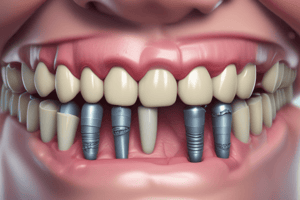Podcast
Questions and Answers
What is the main topic of Lecture 2 in Dental Implantology by Dr. Dastan Tahir Abdallah?
What is the main topic of Lecture 2 in Dental Implantology by Dr. Dastan Tahir Abdallah?
Examination, Investigations, and Applied Anatomy
Why are examinations and investigations important in Dental Implantology?
Why are examinations and investigations important in Dental Implantology?
They help in assessing the patient's oral health and suitability for dental implants.
How does understanding applied anatomy benefit a dental implantologist?
How does understanding applied anatomy benefit a dental implantologist?
It helps in placing implants correctly and avoiding damage to surrounding structures.
In Dental Implantology, what is the primary purpose of examinations and investigations?
In Dental Implantology, what is the primary purpose of examinations and investigations?
Why is applied anatomy considered fundamental for a dental implantologist?
Why is applied anatomy considered fundamental for a dental implantologist?
What distinguishes a successful dental implantologist in terms of their approach to examinations and investigations?
What distinguishes a successful dental implantologist in terms of their approach to examinations and investigations?
What are the key considerations for a dental implantologist when performing examinations and investigations?
What are the key considerations for a dental implantologist when performing examinations and investigations?
How does applied anatomy play a crucial role in the success of dental implant procedures?
How does applied anatomy play a crucial role in the success of dental implant procedures?
Discuss the significance of thorough examinations and investigations in minimizing risks during dental implant procedures.
Discuss the significance of thorough examinations and investigations in minimizing risks during dental implant procedures.
Flashcards are hidden until you start studying




